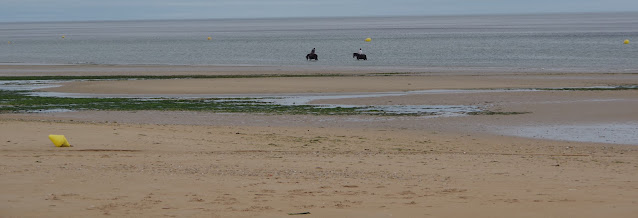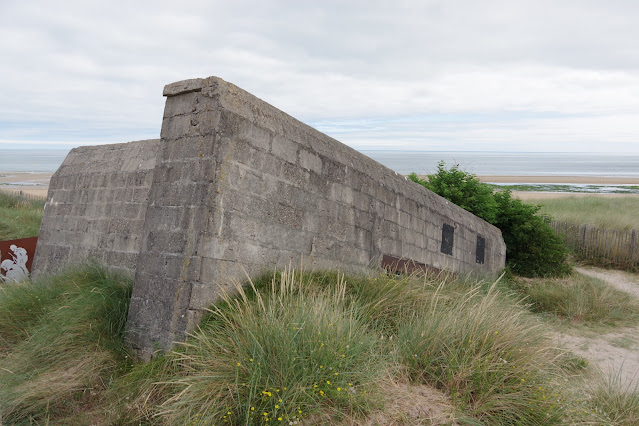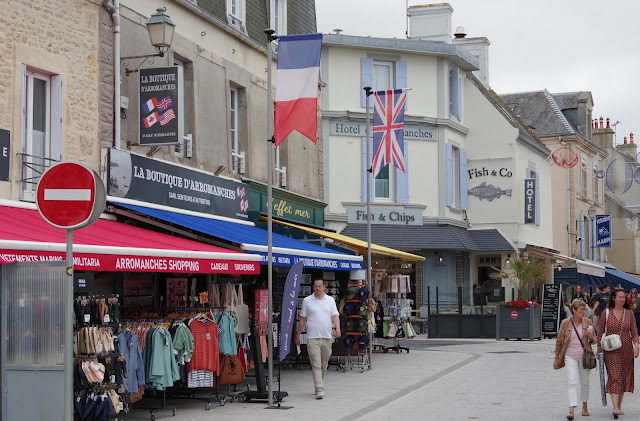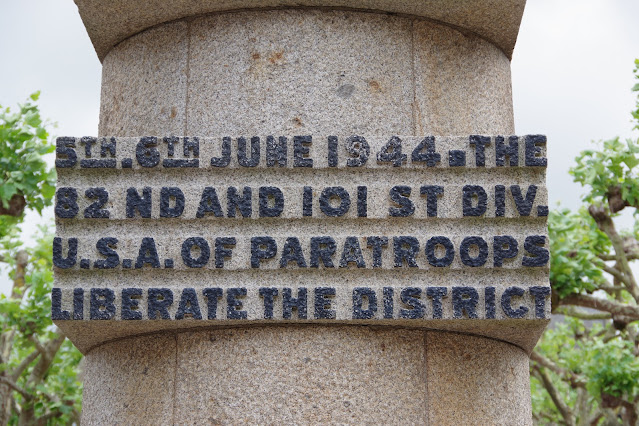... and we who live in that future have a duty to always ensure, that the memory of those who fought and died in Normandy should never become a footnote of history.
This morning, I leave Normandy to drive south to Paris, from there I will catch an afternoon flight to Dublin. Then tomorrow morning I will return to Nova Scotia from Ireland’s capital, marking the end of this marvellous trip ~ Euro 2025.
The high expectations I had garnered for Ireland were vastly exceeded. I had an absolutely fantastic time exploring many parts of this wonderful country, with its incredible rugged scenery and stunning wild Atlantic coast. I deliberately chose lodgings in remote locations, and thoroughly enjoyed the magical Irish welcome and beautiful deep culture in each.
It is often
the case when people visit and enjoy locations within their own country or abroad, they say
~ “I will definitely be back …” ~ I tend not to do that. The reason is simple ~
I believe there are far too many other places that must be seen and
experienced. Therefore, when travelling I prefer to retain my memories with
lots of photos and many written notes, about the things I saw, the people I met and the places I
visited. Having said that, in the case of Ireland, it is with much certainty
that I will return. In my time travelling around, I have created an enormous
thirst to see more of this outstanding country, with its beautiful scenery, dramatic
coastline and friendly culture ~ I felt adopted by the whole country. With Ireland's easy access from Nova Scotia, I could
leave my home in Pleasantville, travel to the airport, take the flight, and in less than seven hours be in Dublin ~ therefore, it makes perfect sense to put Ireland back on
my Bucket List.
It was interesting to note, everywhere I went in this amazing country there was always a pub. Regardless the size of a village or how remote it might be, there was without exception at least one, but usually more. Apparently there are currently 6680 across the 26 counties which make up The Republic of Ireland.
As a result of this visit to Ireland, I now have much more pride over past discoveries from my family tree research, from which I determined that I am 1/8 Irish ~ but have to admit, that I am also 1/8 English ~ I guess nobody can be perfect ...!!!
Ireland and along with its beautiful accent full of outlandish slang, and flowing musical intonations will certainly stay with me for a long time ....
Normandy .....
The sun has risen over the beaches of Normandy many times
since June 6, 1944. The blood that stained the sand has long since washed away. What took place here on D-Day
On the morning of 6 June 1944, by the thousands paratroopers and glider troops were sent behind enemy lines to secure bridges and exit roads. Then at 6:30am, the landings by sea began. By the end of the day, 156,000 Allied troops had successfully stormed and captured five Normandy beaches, but the price that day was high ~ 4441 lost their lives. Less than a year later, the Allies formally accepted Nazi Germany’s surrender. During those eleven months, many more lives were lost on all sides of the conflict, changing not only the future of countries, but that of many families, including my own.
Along the 100Km (62 mile) invasion coastline and inland, I passed countless memorials dedicated to those who died and to the battles they fought. Within the region, I had the enormous privilege of visiting some of the stunning and truly unforgettable war cemeteries maintained by the Commonwealth War Graves Commission (CWGC), American Battle Monuments Commission and Volksbund Deutsche Kriegsgräberfürsorge, all tragically sad and enormously beautiful in equal measures. In complete contrast to the events that brought them into being, they convey a permanent deep sense of peace and tranquility.
Almost 130,000 soldiers, both Allied and German, lost their lives in Normandy in 1944, there are 30 locations which contain their war graves, 2 American, 19 CWGC, 1 French, 6 German, 1 Polish and 1 Russian.
There are
many messages in all war cemeteries, of which I believe the primary one is ~ war
graves are the great communications for peace. I have now stood in many such locations in The Netherlands, Normandy, The Somme in France, Flanders in Belgium and other places in between. When there, it is easy to view the rows of identically shaped
gravestones as uniform and regimented ~ that is partly the impression they are
intended to provide, reflecting the military comradeship these individuals
shared in life, which continues in death.
With every visit I have made to a war cemetery, it always becomes a reminder of the enormous sacrifice made by so many ~ you not only see, but can feel the price of freedom. I will never forget the first time I stood among the rows of pristine white gravestones, immaculate lawns and colourful borders of a CWGC cemetery. It was during April 2000 in Leopoldsburg, Belgium, it was a deep and very personal experience, one that will forever remain etched in my memory.
Reading
each name, each age, each personal inscription engraved with such care into the
hard white stone, is always telling reminder of the human cost of war, as well
as the extraordinary diversity of those involved in it. A visit to any of those
cemeteries or memorials is always a forceful reminder, of the debt we can never
fully repay to those who gave their lives for us.
Last year after my visit to many WWI and WWII cemeteries in The
Netherlands, Belgium and France, I wrote the following ~
“When I look around the world today, there is no peace. I
see far too many wars of aggression inspired by land or sea grabs, religious or
cultural differences, political doctrines and more. There are suppressive
dictators who are highly charged by fear, insecurity and egotism, who at the
expense of their population, continue to develop armaments and weapons that can
reach across the continents and oceans. At the same time as witnessing all
that, I continue to look through the long lens of history to the two great wars
of the 20th century, the beginnings and similarities of how those conflicts
evolved, gives a strong sense that history may be about to repeat itself.
During my recent travels, I have passed many thousands of
acres of consecrated ground, containing tens of thousands of graves, it leads
me to ask ~ have we learned nothing from the past and why do we always want to
do this all over again …?”
~ Unfortunately, a year on from writing that, I am no closer to an answer.
At
Normandy, the guys who came ashore on the morning of June 6, 1944 and in the days afterwards, seen too much in too short a time, living a lifetime in a
day, death had undone so many of them, many hopes and dreams extinguished in
the prime of life. They fought for their country, they fought for their
friends, they fought for their family, they fought for those who might someday
remember them. They left home barely more than boys and returned as heroes. But
to their great credit, that is not how this generation carried itself. After
the war, many put away their medals and were quiet about their service, they rolled
up their sleeves, created the baby boom and moved on. Others who carried shrapnel, scars and deep wounds, found that moving on to be much harder.
Today eight
decades on, the Normandy countryside shows few signs of the savage fighting
that took place during the summer of 1944. The ruined villages, towns and
cities have been restored. The coastal villages from Arromanches to Ouistreham
are once again thriving resorts packed with holiday makers throughout the
summer months. But within all that tourism, I have seen while travelling around
the region, the memory of D-Day and the great Allied invasion has been
carefully preserved. Along the entire Normandy coast are monuments, museums and
cemeteries to remind today’s visitors of the historic events of June 1944.
On my first full day in Normandy, I had to deal with some truly unexpected levels of emotion while visiting the British Sword and Canadian Juno Beaches. Many areas adjacent to both beaches and slightly inland are lined with holiday homes, hotels and restaurants, with folks sitting out on a terrace having lunch, indulging in a glass of wine, all while enjoying what was a light warm breeze bringing with it that lovely aroma of sea salt. On the beaches there were people sun-bathing, swimming, playing sports and taking part in other normal summer activities. Upon seeing this and not giving much consideration to anything else, I began to feel a burning indignation, which almost bordered on outrage. I was allowing my thoughts and my sight, to unjustly assume a lack of respect towards the memory of those lads, who had been cut down just a few feet away on those beaches. I was only at the beginning of my Normandy visit and genuinely felt, that I could not go ahead with the plans I had made for the days ahead. In parallel with reality of the summer activities going on around me, within my thoughts I could see the gloomy grey skies that hung over Normandy on that June 6th, 81 years ago ~ the treacherous waves battering landing craft, young soldiers sea sick in the swells, bullets flying over their heads, the ramps going down, with even more hell about to be unleashed. Machine gun nests attacking, sending thousands of rounds to bite into flesh, explosions followed by the screams of agony, and then the blood-soaked sea. I began to see the images of those painful notifications that would come later, in the form of telegrams from the war office, sent to so many mothers and new widows. I know about those brief but tragically direct messages, which every family with a son or husband in uniform learned to fear, in my family I had five relatives killed in war, the accounts of those telegrams arriving have been passed down to me ~ therefore such things have become personal.
Growing up I
had seen firsthand and recognized even as a young child, the impact those family losses
had over the decades, particularly with my father, but also, with my grandparents
and others within the family, the fallout and grief never diminished or
lessoned with time. I was raised to respect and maintain the memory those relatives killed in war, to never
forget all they had given up and where they gave it up ~ during that first morning in Normandy at Sword and Juno Beaches, I was looking across the sand, to where so many “gave
it up”, and it was having an enormous and profound affect upon me.
Sitting initially
at Sword Beach, with everything that was going on around me and in my head, I
knew that I had to bring my thoughts and emotions into check. I had to consider
the reasons for D-Day and what it was actually about. The guys who came ashore
on those beaches, did so to liberate Europe, and return democracy to those who had been living and suffering under five long
years of a brutal and restrictive military occupation. The liberation began with an Airborne drop behind enemy lines, followed by Allied footsteps on those beaches. It continued through France, into Belgium and The Netherlands, until many
of the survivors of D-Day reached Berlin some 11 months later. Their aim that
day, along with many other campaigns and sacrifices that followed until Victory in Europe Day (V.E. Day), was to return the basic freedoms
without restrictions to those that had been occupied ~ and yes I concluded, that means the freedom to enjoy without limitations the beautiful Normandy coast.
I have no idea what my expectations were prior to my visit, perhaps it was to see the beaches restricted in a sacred and consecrated way, set apart and venerated to
a point of being fenced off memorials. In truth when one thinks
about the geographical reach of both WWI and WWII, there are many places in
Europe and in fact the world, that 20th century history will forever record as Killing Fields. Vast areas like those Normandy beaches that bear witness to wars human devastation, destruction
and deep personal loss ~ it would be impossible and completely impractical to treat or claim all
those lands and seas as revered memorials.
Even as early as it was that first full day in Normandy, I had already seen while on my way to Sword and Juno Beaches, the recognition and deep respect for what happened here during summer 1944. During my travels on the days that followed , I became thoroughly aware that this part of the Normandy region, is dedicated in many respectful and appreciative ways to maintaining the rightful memory of those who came ashore here. Within this region of France, the legacy of those who died on each of the five beaches and in the areas to the south, is in very good hands. It only takes a short drive through the countryside or a walk along a seafront, to be summoned back to the realities of D-Day and the Normandy campaign.
I have learned firsthand on my travels to World War sites in The Netherlands, Belgium and France, the people of those countries will never forget the men who came to mend their future.
Poem "The Longest Day" by Rob Aitchison ~
Do not call me hero
When you see the
medals that I wear
Medals maketh not the
hero
They just prove that
I was there
Do not call me hero
Now that I am old and
grey
I left a lad returned
a man
They stole my youth
that day
Do not call me hero
When we ran the wall
of hail
The blood, the fears,
the cries, the tears
We left them where
they fell
Do not call me hero
Each night I stop and
pray
For all the friends I
knew and lost
I survived my longest
day
Do not call me hero
In the years that
pass
For all the real true
heroes
Have crosses, lined
upon the grass
From the Imperial War Museum, an American-commentator's account of some of the action that took place during the Normandy Landings, click on the image or the link below ~
https://www.youtube.com/watch?v=PjCR9YrU2Q0



























































































